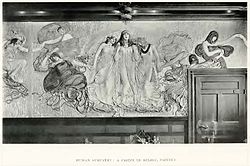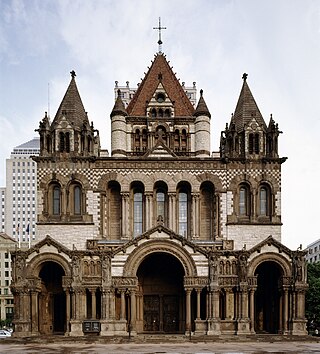
Richardsonian Romanesque is a style of Romanesque Revival architecture named after the American architect Henry Hobson Richardson (1838–1886). The revival style incorporates 11th- and 12th-century southern French, Spanish, and Italian Romanesque characteristics. Richardson first used elements of the style in his Richardson Olmsted Complex in Buffalo, New York, designed in 1870, and Trinity Church in Boston is his most well-known example of this medieval revival style. Multiple architects followed in this style in the late 19th century; Richardsonian Romanesque later influenced modern styles of architecture as well.

James Wyatt was an English architect, a rival of Robert Adam in the neoclassical and neo-Gothic styles. He was elected to the Royal Academy of Arts in 1785 and was its president from 1805 to 1806.
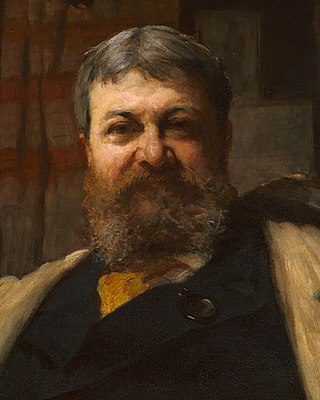
Henry Hobson Richardson, FAIA was an American architect, best known for his work in a style that became known as Richardsonian Romanesque. Along with Louis Sullivan and Frank Lloyd Wright, Richardson is one of "the recognized trinity of American architecture."
The year 1894 in architecture involved some significant events.

Bushey is a town in the Hertsmere borough of Hertfordshire in the East of England. It had a population of 25,328 in the 2011 census, rising to 28,416 in the 2021 census, an increase of 12.19%. This makes Bushey the second most populated town in Hertsmere. Bushey Heath is a large neighbourhood south east of Bushey on the boundary with the London Borough of Harrow reaching elevations of 165 metres (541 ft) above sea level.

The Back Bay Fens, often called The Fens, is a parkland and urban wild in Boston, Massachusetts, United States. It was established in 1879. Designed by Frederick Law Olmsted to serve as a link in the Emerald Necklace park system, the Fens gives its name to the Fenway-Kenmore neighborhood.

Sir Hubert von Herkomer was a Bavarian-born British painter, pioneering film-director, and composer. Though a very successful portrait artist, especially of men, he is mainly remembered for his earlier works that took a realistic approach to the conditions of life of the poor. Hard Times showing the distraught family of a travelling day-labourer at the side of a road, is one of his best-known works.

Bushey Museum is in Bushey, Hertfordshire. It was officially opened as a volunteer-run museum in October 1993, having achieved Full Registration with the Museums and Galleries Commission. In the week prior to opening, the Museum won joint first prize in the prestigious Gulbenkian Foundation Awards for the best achievement by museums operating with limited resources. The building, on Rudolph Road in Bushey, had been built in 1909 as the offices of Bushey Urban District Council, and had passed to Hertsmere Borough Council on local government reorganisation in 1974.

Lucy Elizabeth Kemp-Welch was a British artist and teacher who specialized in painting horses. Though increasingly overlooked after the Second World War, from the late 1890s to the mid-1920s she was one of the country's best-known female artists. As her obituary in The Times noted, 'Like most artists who came to maturity and were established before the end of the nineteenth century, Lucy Kemp-Welch suffered somewhat in her later reputation from the violent changes in art which followed. In her prime as an animal painter she held a position in this country comparable to that of Rosa Bonheur in France, and the only British woman artist of her generation who was more talked about was Lady Elizabeth Butler, painter of "The Roll Call".' Her reputation has since revived, and she is best known today for her large paintings of wild and working horses in the New Forest, and those in military service which she produced during the First World War, as well as for her illustrations to the 1915 edition of Anna Sewell's novel Black Beauty.

Gaddesden Place, near Hemel Hempstead in Hertfordshire, England, was designed by architect James Wyatt and built between 1768 and 1773, and was the home of the Hertfordshire Halsey family.
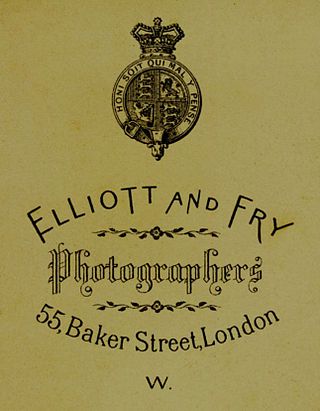
Elliott & Fry was a Victorian photography studio founded in 1863 by Joseph John Elliott and Clarence Edmund Fry. For a century, the firm's core business was taking and publishing photographs of the Victorian public and social, artistic, scientific and political luminaries. In the 1880s, the company operated three studios and four large storage facilities for negatives, with a printing works at Barnet.

The John N. Bagley House, also known as Bagley Mansion, was built as a private residence in 1889. The mansion is located at 2921 East Jefferson Avenue in Detroit, Michigan. It was listed on the National Register of Historic Places in 1985. As of 2022, the house is used as a commercial office building, maintaining its historic features and character.
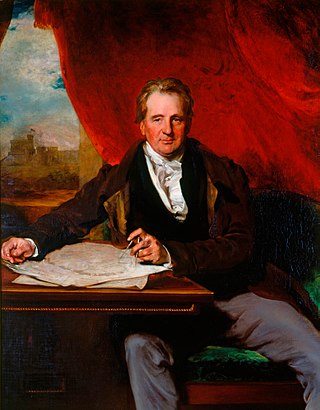
Sir Jeffry Wyatville was an English architect and garden designer. Born Jeffry Wyatt into an established dynasty of architects, in 1824 he was allowed by King George IV to change his surname to Wyatville. He is mainly remembered for making alterations and extensions to Chatsworth House and Windsor Castle.

David John Williams (1868–1949) was a British actor. He also directed one film, The Shuttle of Life, which starred Evelyn Brent.

Hilfield Castle, also Hilfield Lodge, is a country estate and house about 2 miles (3.2 km) east of Watford and 1 mile (1.6 km) southwest of Aldenham, in Hertfordshire, on the outskirts of London in the United Kingdom. The estate contains two large reservoirs, one of which were built by French prisoners of war in the 1790s,. The grounds now form Aldenham Country Park. Elstree Aerodrome is located just to the east and the M1 motorway passes to the west.
Bushey Studios was a British film studio located in Melbourne Road, Bushey, Hertfordshire which operated between 1913 and 1985. The studios were built by the film enthusiast Hubert von Herkomer in the grounds of his country house, Lululaund. They gradually took on a more professional air and in 1915 they were acquired by the British Actors Film Company for use as their principal production base. After the company ran into problems, the studio was closed during much of the 1920s. During the 1930s film boom, it was re-opened and used to produce a number of quota quickies.
Harry Fidler (1856–1935) was a British painter known for including farm animals and especially horses in his impressionistic paintings, typically using heavy impasto. He married Laura Clunas, who was an artist with a similar style.

Daniel Albert Wehrschmidt, also known as D. A. Veresmith, was a German-American artist from Ohio who made a career for himself in England as a portrait painter, lithographer, and engraver.

Bushey Rose Garden is a rose garden in Bushey, Hertfordshire, England.
Elizabeth Gulland was a Scottish-born printmaker and painter.




